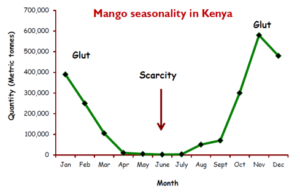The plight of smallholder mango farmers in Kenya during the peak season
The mango season in Kenya that began in November has just ended. Typical of the peak season, mangoes were literally everywhere, you could walk on them as you made your way into the market! If you did not know better, you might have thought that mango farmers were reaping big from the work of their hands. Unfortunately the mango season is a painful one for majority of the farmers because it is the time they count their losses.During the 4-5 months when mangoes are in season, there is an oversupply (with a peak between December and February) leading to enormous losses. At every stage of the supply chain from the farm gate to the consumer, some loss/wastage occurs. In Kenya the post-harvest losses in the mango supply chain are estimated to range between 40 -50% but higher figures have been cited in some studies.

Mango is a highly perishable fruit with a shelf life of 2 – 10 days depending on the stage of ripeness (maturity). Majority of the smallholder farmers have no proper storage facilities and technologies to preserve quality and/or extend the shelf life. Therefore once the fruits mature or ripen they have to harvest and sell them at any price offered at the farm gate or let the fruits over-ripen and fall off the tree. This situation exposes them to exploitation by traders (mainly brokers) who offer very low prices for the fruits.
The prices
During the peak season, the farm price ranges from 2 – 5 KSH per piece. A few farmers may be lucky to sell their fruits to exporters at a price of 7 – 10 KSH per piece. How much do the mango cost at the retail outlets in Nairobi? A price survey for ‘Apple mango’ in major retail outlets revealed shocking results. The fruit costs between KSH 45 to 66 per piece in these retail outlets in Nairobi – this is 10 to 30 times the farm gate prices!

The losers and profiteers
The cost of the 40 – 50% post-harvest losses mentioned above has to be borne by some of the actors in the mango supply chain. Of all the actors in this supply chain, the most vulnerable one who bears the cost of the losses is the smallholder farmer. All the other actors (brokers, wholesalers, retailers etc.)ensure that the price of the mangoes at their stage includes a profit margin. The price at retail or wholesale market is fixed on the understanding that a certain percentage of the mangoes will be wasted. Unfortunately majority of these traders do not make much effort to reduce the wastage. If they made an effort then the wastage would be reduced and they would probably pay a little more for the fruits – ultimately leading to better returns for the farmers.As a result of this situation, majority of the farmers do not make much from mango production to derive a decent living out of their farming efforts.
Can the situation be better?
This situation can improve if farmers got some bargaining power and were not at the mercies of brokers. This can be achieved if the farmers worked in groups. Majority of the smallholder farmers do not produce sufficient volumes to attract the traders as individuals. However if they formed groups, they would be able to pool their mangoes and bargain for better pay from the buyers. They can also seek to market the fruits directly to major outlets such as supermarkets in the big cities or to processors. To be able to bulk their fruits over time, the farmers require cold storage facilities to slow down ripening/deterioration as they await dispatch to the various market outlets. Conventional cold room facilities are generally expensive and un-affordable for majority of the smallholder farmers. The good news is that there are low-cost cold storage technologies for the farmers. An example of such technologies is the Coolbot™ which is being piloted by University of Nairobi for mango farmers in Makueni County. The technology was recently introduced in Kenya in a pilot study sponsored by USAID under the Kenya Feed the Future Innovation Engine. This technology has been shown to work effectively to extend the shelf life of mango fruits. The farmers have therefore been encouraged to form groups so as to benefit from the technology and economies of scale occasioned by such as move. Apart from preserving the mangoes for the fresh market, the fruits can be processed into shelf-stable products such as juices, concentrates, jams, purees etc. For farmers to do this, they have to be trained on best practices in processing and the certification process for their products to access the markets. Mango fruits can also be dried/dehydrated to produce delicious and nutritious mango chips which can be eaten as snacks instead of unhealthy junk foods.There are several initiatives aimed at addressing the plight of mango farmers but a lot more needs to be done.
By Dr. Jane Ambuko
The writer is a senior lecturer and head of horticulture, Department of Plant Science and Crop Protection, University of Nairobi. E-mail jane.ambuko@uonbi.ac.ke OR ambuko@yahoo.com

